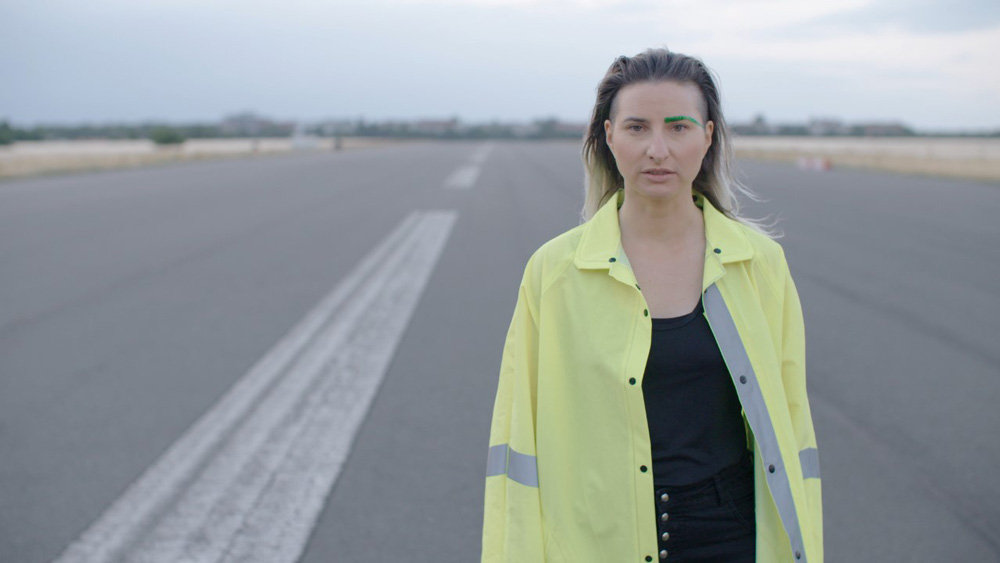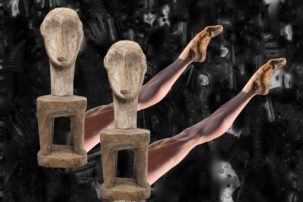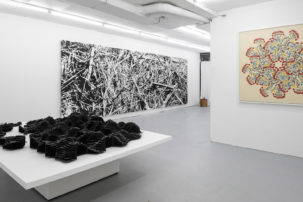Control over one’s body, its movements or even its location, is a privilege many people take for granted and a reality that those who lack control must abide. “Automatisme ambulatoire” comes from a pathological term coined in France in the late 1800s to describe an irrepressible compulsion to move the body or to wander in a dissociated state. Falling under the era’s catch-all diagnosis of hysteria, such movements were often imitated in early French cabaret and cinema as a form of physical humour. Australian-born and California-based curator Amanda Cachia recognized this mimesis as significant to the contemporary experience of inhabiting a marginalized body. Cachia brings six new works together in “Automatisme Ambulatoire: Hysteria, Imitation, Performance,” an exhibition that jostles current understandings of mimicry and movement related to bodies that exist outside the so-called neutrality of the normative.
In several works this relationship manifests through crip aesthetics—defined as the way by which physical difference can inform and inspire rather than limit artistic output. Claire Cunningham’s work delivers this notion perhaps most concretely. In her performance and installation tributary (2019), she and her collaborator Vicky Malin movements taught to them by a professional Elvis impersonator. As Cunningham—clad in a tracksuit and satin cape—mimics and humorously narrates Elvis’s signature moves such as pelvic thrusting, rapid shaking and abrupt turn-ins of the knees, she asks the audience to consider how these actions—when produced by the normative body of a celebrity—are iconic, yet when performed by someone using crutches and for whom these erratic behaviours are conceivably or stereotypically expected, are prone to initiate discomfort for the viewer. Ultimately, the performance is not a tribute to Elvis, but to crip movement, and to the lifelong conditioning imposed on disabled individuals to strive to appear able-bodied—a tribute to mimicry itself.
The physical manifestation of complex circumstances carries through in the video work Gems and Minerals (2018), by Diane Borsato, in which museum guides in the Earth’s Treasures Gallery at Toronto’s Royal Ontario Museum narrate geological history and articulate concerns about resource extraction through a combination of dance and ASL (American Sign Language). The performances are densely emotional, capturing the intangibility of geologic time and the urgency of the climate crisis in methods unbound by semantics or typical institutional knowledge-sharing practices.
In an adjacent gallery, another video work takes an exclusively linguistic approach to a similarly urgent issue—the refugee crisis. In Pauline Boudry and Renate Lorenz’s piece The Right to Have Rights (2019), a woman stands on an abandoned airport runway in Berlin and delivers the text of the 1951 Refugee Convention, wherein 145 states promised rights to those seeking refuge. The law-speak in which the text is written (which includes the term “alien” to describe migrants) combined with the pseudo-futuristic electronic distortion of the performer’s voice further distances the message from the humanity it references. Hearing the now 70-year-old edict that refugees be granted “freedom of movement…to choose their place of residence and move freely within its territory” speaks to the failure of signatories to provide body autonomy for migrant populations to this day. Installed in a blacked-out room with the large projection facing away from the door on a dramatic slanted platform, The Right to Have Rights creates a disorienting and unnerving physical experience that mirrors the psychological turmoil of seeking sanctuary.
“Automatisme Ambulatoire” is a diverse, philosophical and complex exploration of representation. The works mentioned, as well as the three others—Brendan Fernandes’s performance-activated installation The Rite (2019); collective My Barbarian’s audio composition, film and installation Hystera Theater (2019); and Every Ocean Hughes’s sculptural installation Help/What/The New York Times (2019)—together explore power dynamics and care as they relate to the body, its movements and the ways we choose to emulate or reject them. In addressing disability, mortality, privilege and social justice, this exhibition demonstrates the creative potential that uncontrolled movement has in physical as well as political resistance.

Pauline Boudry and Renate Lorenz, The Right to Have Rights (still), 2019. Installation with HD video, 6 min. Courtesy the artists.

Brendan Fernandes, The Rite, 2019. Performance-activated installation. Courtesy the artist.

Diane Borsato, Gems and Minerals (still), 2018. Video, 25 mins. Courtesy the artist.

My Barbarian (Malik Gaines, Jade Gordon and Alexandro Segade), Hystera Theater (video still), 2019. Mixed-media installation. Courtesy the artists.

 Claire Cunningham, tributary, 2019. Live performance and installation. Courtesy the artist.
Claire Cunningham, tributary, 2019. Live performance and installation. Courtesy the artist.






